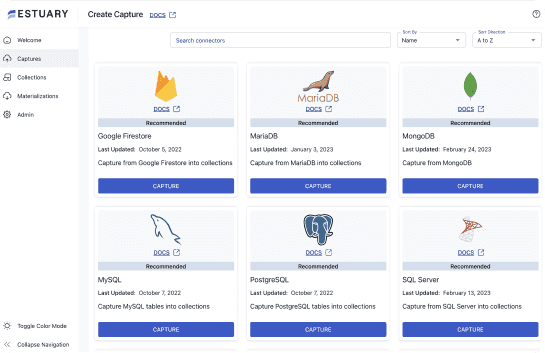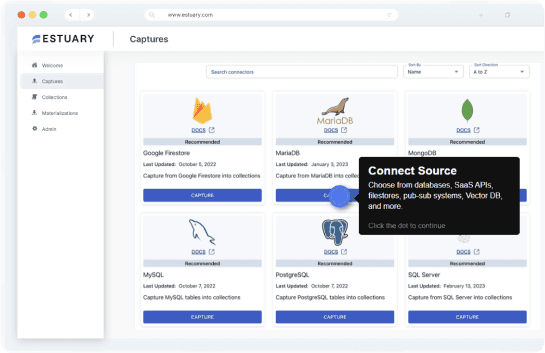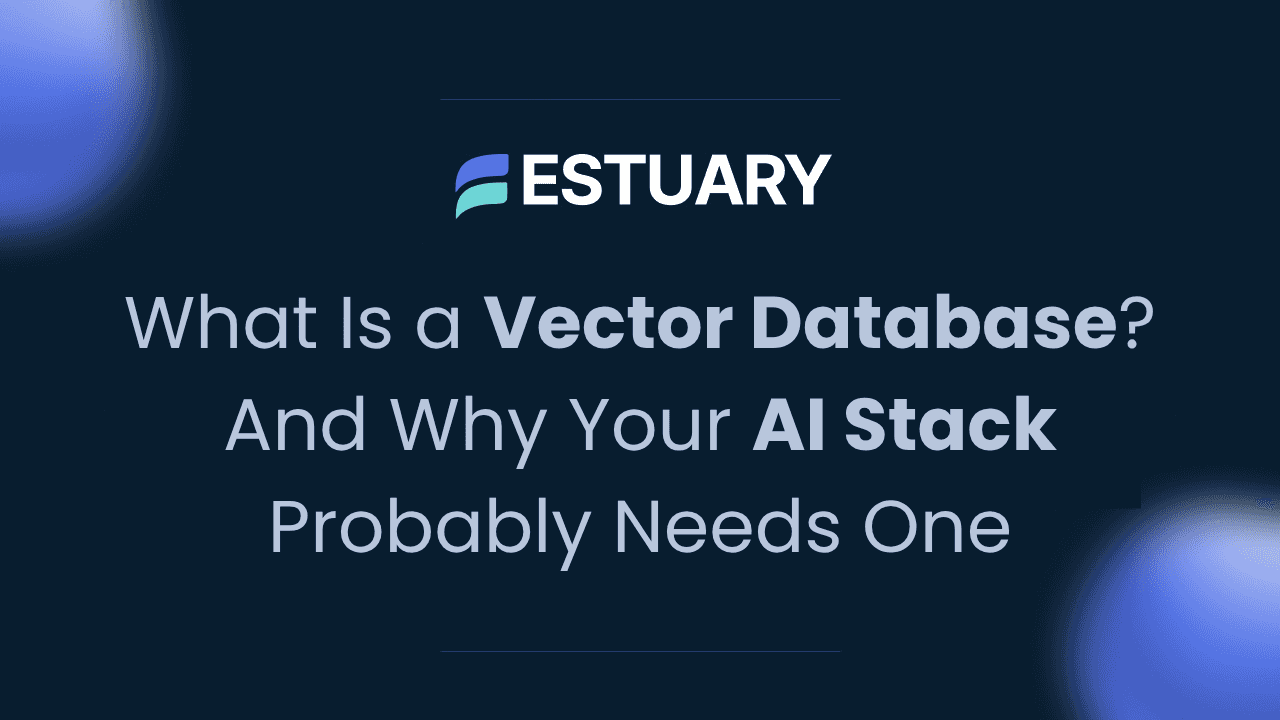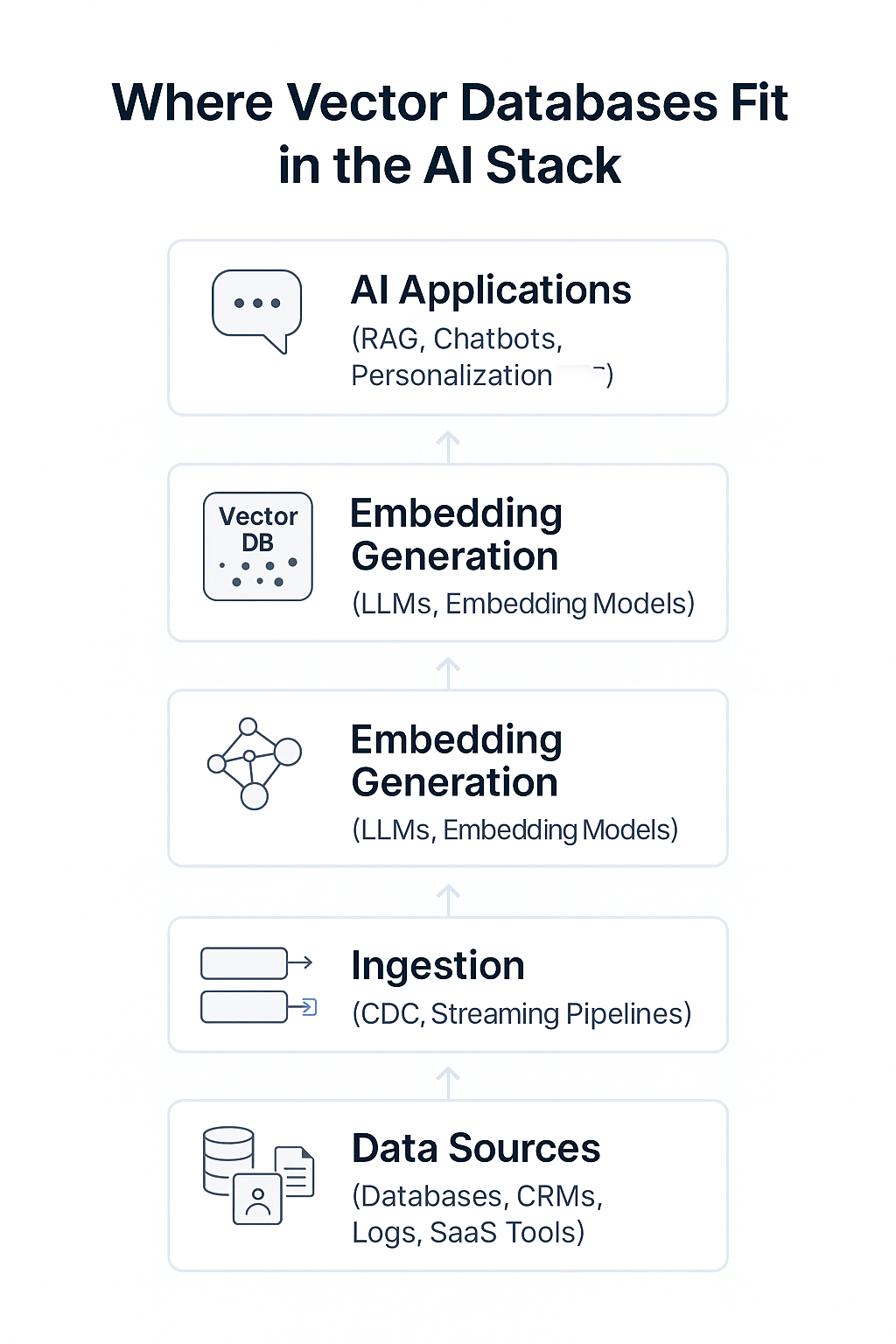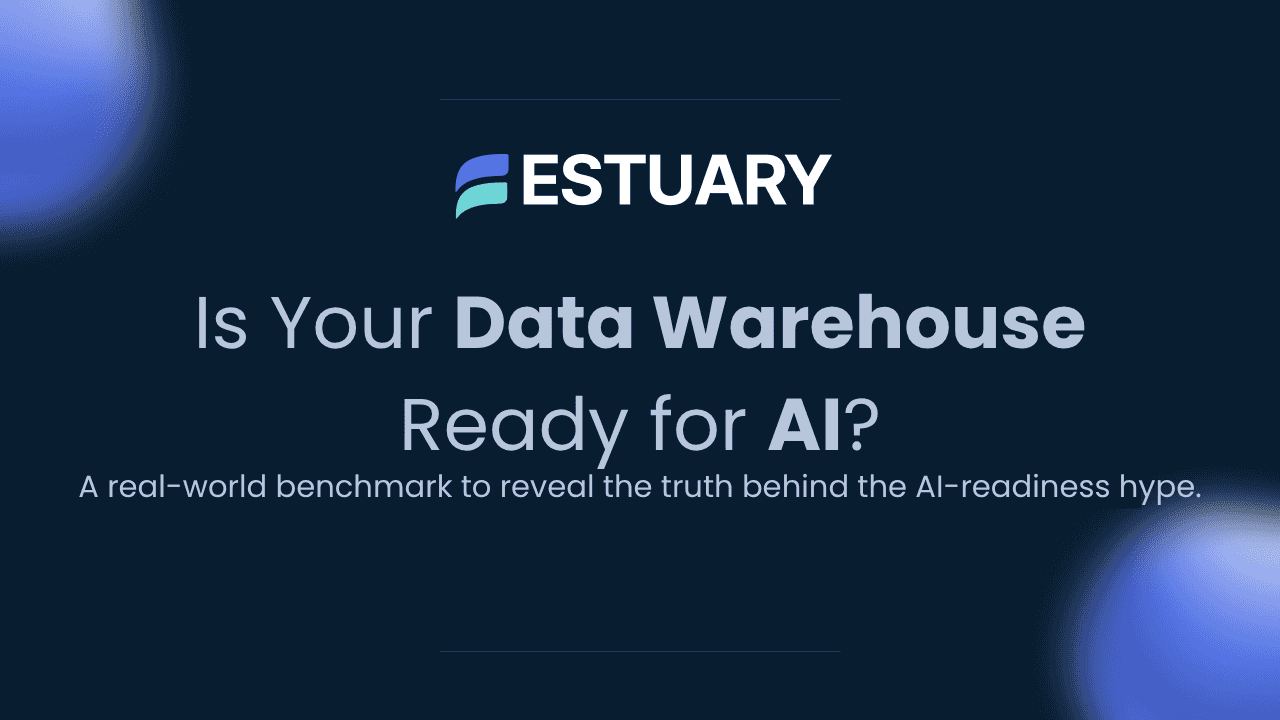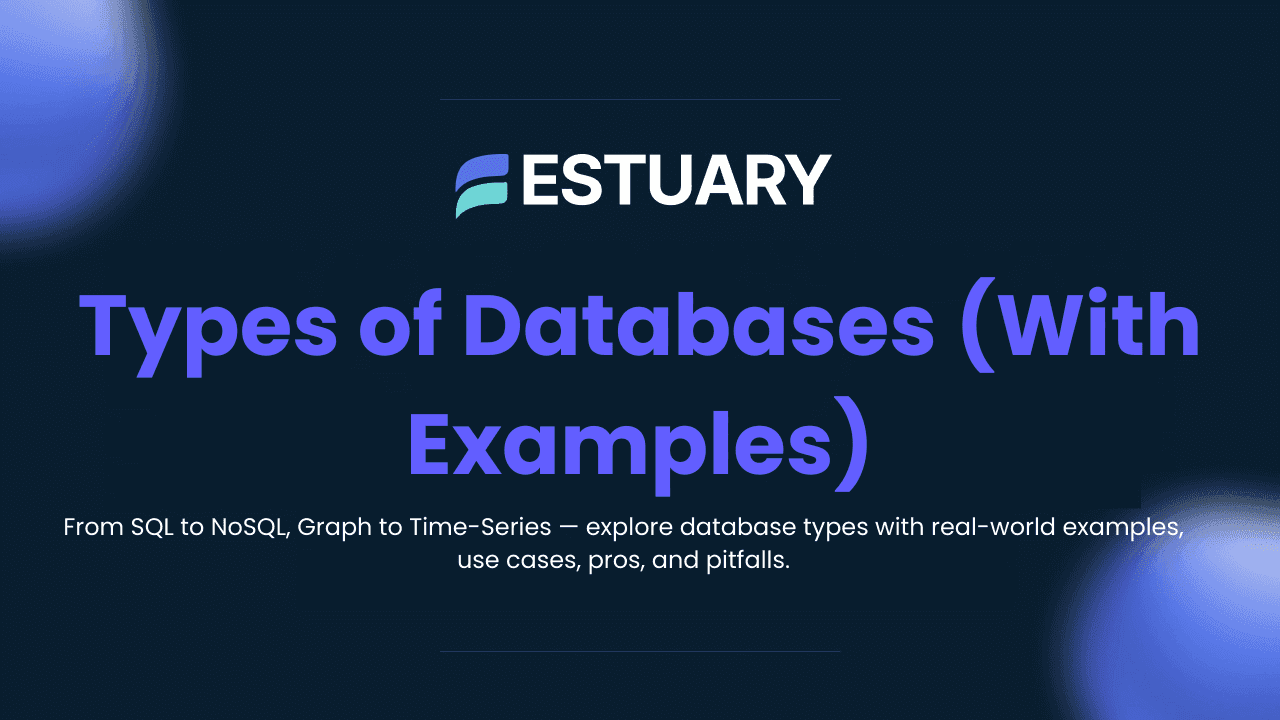
What is a Vector Database?
A vector database is a specialized data system designed to store and search high-dimensional vectors — the numerical representations of complex data like text, images, audio, or user behavior.
In traditional databases, you might search for exact matches using SQL. In a vector database, you're looking for similarity. For example, instead of searching for the exact word "smartphone," you can search for products that are semantically similar to "latest Android phone under $500." The results aren't keyword matches — they're based on vector proximity.
Here’s how it works in practice:
- First, raw data (like text or images) is converted into embeddings using machine learning models. These embeddings are fixed-length numeric vectors.
- The vector database stores these embeddings efficiently and indexes them using approximate nearest neighbor (ANN) algorithms like HNSW or IVF.
- When a query is made (e.g. a search phrase, chatbot input, or document), it’s also converted into a vector, and the system retrieves the most similar vectors based on distance metrics like cosine similarity or Euclidean distance.
This approach is core to many AI-powered applications today, including:
- Semantic search
- Recommendations
- Chatbots and RAG (retrieval-augmented generation)
- Fraud detection
- Image and audio classification
While vector storage can be added to traditional databases using extensions (like pgvector for Postgres), purpose-built vector databases are optimized for speed, scale, and recall quality in high-dimensional search.
Vector databases aren’t a niche tool anymore; they’re becoming essential infrastructure for any modern AI stack.
Why Vector Databases Matter for AI and LLM Workloads
As AI systems become more advanced, the way they interact with data is changing. Traditional databases were designed for structured records and exact matches. But AI, especially large language models (LLMs), thrives on patterns, similarity, and context.
That’s exactly where vector databases come in.
Modern AI workloads rely on embeddings. These are numeric representations of data like text, documents, or user behavior that capture meaning rather than literal content. LLMs use these embeddings to understand and compare information more like a human would.
Here are just a few use cases that depend on fast, accurate vector retrieval:
Retrieval-Augmented Generation (RAG)
In RAG systems, an LLM retrieves relevant context from a knowledge base before generating a response. That knowledge base is often stored in a vector database. The better and faster that retrieval is, the more accurate the response becomes.
Semantic Search
Unlike keyword search, semantic search understands intent. For example, a user searching for "quiet vacation spots" could be matched with "peaceful nature retreats" or "remote beach towns." Vector similarity makes this possible.
Recommendations and Personalization
Vector representations of users and products can be compared in real time to recommend content, products, or actions based on behavioral similarity, not just categories or filters.
Multi-modal AI
As models begin working across text, images, and even audio, vector databases serve as the unifying layer for storing and comparing different types of embeddings in one place.
These workloads require low latency, high recall accuracy, and the ability to work across structured and unstructured data. Traditional databases weren’t built for this. Vector databases fill that gap and are becoming foundational to AI production systems.
In short, if your company is building or scaling LLM applications, you need a reliable vector database in your stack.
Popular Vector Database Options
As demand for vector-native infrastructure grows, the number of tools offering vector storage and retrieval has exploded. Some are purpose-built vector databases, while others are traditional databases extended with vector capabilities.
Here are some of the most widely adopted options in the market today.
Pinecone
Pinecone is a fully managed, cloud-native vector database focused on high-performance similarity search. It uses approximate nearest neighbor (ANN) indexing techniques like HNSW and provides a scalable API for storing and querying vectors. Pinecone is popular in enterprise LLM workflows and integrates easily with OpenAI and LangChain.
pgvector (PostgreSQL Extension)
pgvector brings vector search to Postgres. It allows developers to store embeddings as arrays and run similarity queries using built-in distance functions. While not as fast as specialized vector databases at scale, pgvector is ideal for teams already using PostgreSQL who want to add semantic search or RAG capabilities without managing a new system.
Weaviate
Weaviate is an open-source vector database with built-in support for hybrid search (keyword plus vector). It offers automatic vectorization through integrations with Hugging Face, OpenAI, and Cohere. Weaviate also supports metadata filtering, making it useful for use cases that require structured and unstructured search.
Milvus
Milvus is another open-source vector database known for high-speed indexing and scalability. It supports multiple ANN algorithms and offers fine-tuned control over indexing parameters. Milvus is often used in image, video, and audio-based search applications and is part of the Zilliz ecosystem.
Qdrant
Qdrant is an open-source vector search engine that emphasizes real-time filtering, relevance scoring, and developer experience. It supports payload filtering and is optimized for both production and prototyping environments.
These tools differ in terms of speed, scale, hosting model, and ease of integration. Choosing the right one depends on your data type, performance needs, and how often your vectors are updated or replaced.
In the next section, we’ll show how these databases fit into the broader AI stack and why data movement to them is often overlooked.
Where Vector Databases Fit in the AI Stack
Vector databases are not standalone tools. They’re one part of a growing ecosystem of systems and services that power modern AI applications. Understanding where they fit helps clarify both their value and their limitations.
In a typical production-grade AI stack, you’ll find five essential layers:
1. Data Sources
These include databases, CRMs, SaaS tools, documents, logs, and any other system where raw data lives. This is where embeddings originate, either directly or through transformation.
2. Ingestion and Transformation
Before you can create embeddings, raw data needs to be captured and prepared. This often involves change data capture (CDC), batch ingestion, or real-time streaming. Some teams write custom pipelines, while others use platforms like Estuary to handle this layer with low latency and scale.
3. Embedding Generation
This is where machine learning models convert raw data into vectors. Tools like OpenAI, Hugging Face, Cohere, or custom encoders are used to embed text, images, or other formats.
4. Vector Database
The embeddings are stored and indexed here. The vector database enables fast similarity search based on input queries, which might come from a chatbot, semantic search, or another application layer.
5. Application Layer
This is where user interaction happens. It might be an LLM using retrieval-augmented generation, a semantic search box on a website, or a recommendation engine. The application queries the vector database to retrieve relevant information in real time.
This architecture works best when each layer communicates efficiently. But in many stacks, the weakest link is between the ingestion layer and the vector database.
Most teams focus on the embedding model or vector database itself but underestimate the importance of keeping vectors fresh and in sync with real-world events. Without this, even the most advanced system is working with outdated context.
That brings us to one of the most overlooked challenges in vector-based AI systems: data freshness.
The Hidden Bottleneck: Syncing Fresh Data into Vector Databases
Most vector database discussions focus on retrieval speed, recall accuracy, and model quality. But in real-world AI systems, the bigger problem often happens earlier.
It’s not about how fast your queries run.
It’s about how fresh your vectors are.
LLMs and AI applications rely on current context. But if the embeddings in your vector database are out of date, the responses your system generates will be too. This happens more often than you might expect.
Why does data freshness matter?
Let’s say your system powers a chatbot that retrieves support tickets from a helpdesk platform. If a customer updates their ticket or a resolution note is added, but the vector DB hasn’t been updated, your LLM may surface stale or irrelevant information.
The same issue shows up in ecommerce, finance, logistics, and healthcare. A product might change categories. A transaction might be flagged. A user might cancel. Without real-time updates to the vector index, your AI stack quickly loses accuracy and reliability.
What makes syncing difficult?
Here’s where things get tricky.
- Most ingestion pipelines are batch-based. They sync every 6, 12, or 24 hours.
- Embedding generation is often decoupled from updates.
- Pipelines are brittle, and maintaining backfills or re-embeddings is time-consuming.
- Vector DBs are fast, but they can’t index what they don’t receive.
As a result, the vector layer is often several steps behind your actual data, which defeats the purpose of using AI for dynamic decision-making in the first place.
A better approach
To make vector databases truly production-ready, teams need to rethink the pipeline. That means:
- Using streaming or incremental CDC instead of scheduled batch loads
- Automating embedding refresh when source data changes
- Minimizing pipeline latency from source to vector index
Some modern data platforms now support real-time vector sync directly. Estuary Flow, for example, can capture changes from operational databases or SaaS tools, transform the data in motion, and trigger downstream embedding updates with minimal delay.
The result is a vector database that actually reflects your live data, not yesterday’s snapshot.
If you’re building LLM-powered apps or real-time AI features, solving this bottleneck early will save you time, money, and a lot of debugging down the road.
Want to Know Which Data Warehouses Can Keep Up?
If you’re investing in AI and LLMs, choosing the right vector database is only half the battle.
The real performance test lies upstream in your data infrastructure. Your embeddings are only as fresh and useful as the data pipeline behind them.
So, how do you know if your existing warehouse or database can support this kind of workload?
We ran a deep technical benchmark to find out.
Estuary tested five of the most popular cloud data warehouses against a set of modern, AI-relevant query patterns, including streaming ingestion, semi-structured data, and high-concurrency access.
The results surprised even us.
Some warehouses showed impressive consistency under pressure. Others broke down when handling real-time or iterative workloads typical of AI applications.
If you're building for RAG, real-time personalization, or any vector-powered use case, this benchmark can help you:
- Identify which platforms are AI-ready
- Understand query behavior under load
- Avoid costly performance tradeoffs in production
Get the full breakdown with metrics, insights, and architectural recommendations.
[→ Download the Benchmark Report]
FAQs
What are some popular vector databases?
Are all data warehouses suitable for supporting vector database workloads?

About the author
Team Estuary is a group of engineers, product experts, and data strategists building the future of real-time and batch data integration. We write to share technical insights, industry trends, and practical guides.

